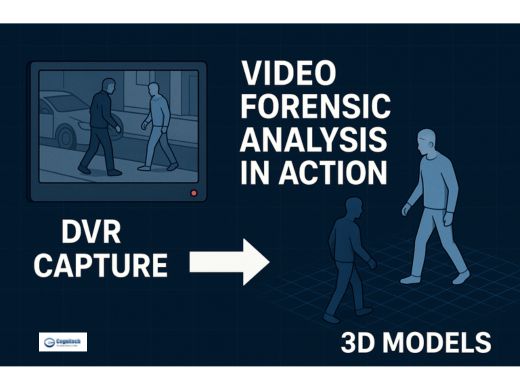From DVR Capture to 3D Models: Video Forensic Analysis in Action
If you’ve ever watched a crime drama, you’ve seen the classic scene: detectives huddle around grainy video footage, zooming in until a blurry face becomes crystal clear. In reality, it’s not that simple. But with today’s forensic video analysis tools, investigators really can pull powerful details from raw footage and sometimes even build entire 3D reconstructions of a crime scene. That’s not TV magic. That’s the evolution of video forensic analysis in action.

The Starting Point: DVR Capture
Most investigations begin with video pulled from DVRs – surveillance systems, dash cams, or body cameras. The problem is, DVR footage is often locked into strange formats that aren’t easy to review. Worse, transferring the files can sometimes damage the evidence if it’s not done correctly.
This is where specialized software like Cognitech VideoActive® 64 makes the difference. Its real-time DVR capture is patented to ensure nothing gets lost in translation. Every frame is recorded exactly as it appeared, with lossless encoding that preserves quality while actually saving storage space. For investigators, that means they don’t just get the footage—they get reliable evidence that can hold up in court.
Cleaning Up the Chaos
Raw video is rarely perfect. It may be too dark, too shaky, or filled with distracting elements. Video forensic analysis steps in here to enhance what’s already there without altering the truth. Features like Real-Time Track & Cover allow analysts to follow a suspect through crowded spaces, while de-multiplexing tools instantly separate multiple camera feeds bundled into one file.
Think of it this way: instead of spending hours piecing together fragmented footage, investigators can immediately jump to the critical details. That time savings is huge when cases move quickly and decisions can’t wait.
Beyond Two Dimensions: Lidar Crime Scene Reconstruction
Where things get really interesting is when video evidence is paired with lidar technology. Traditionally, investigators would measure a crime scene by hand, snapping photos and sketching layouts. It was time-consuming and prone to errors. Now, lidar scans can capture every angle and measurement of a scene in incredible detail.
With Cognitech’s tools, those lidar scans can be fused with video footage to create 3D models of crime scenes. Investigators don’t just watch what happened—they can step into a digital recreation, walk through the environment, and see it from different perspectives. That level of detail can reveal insights that a flat video never could, like exact distances, object placement, or a suspect’s line of sight.
Multi-Channel Fusion: Putting the Puzzle Together
Of course, most cases don’t rely on a single piece of video. There are usually multiple cameras – different angles, different qualities, even different times. Multi-Channel Fusion brings them all together.
This feature combines feeds from multiple sources into one synchronized, unified view. Imagine lining up security footage from inside a store with exterior cameras and a body cam outside. Suddenly, investigators see the full picture of a suspect’s movements instead of disjointed fragments. It’s like piecing together a puzzle, but the software does the heavy lifting.
Why This Matters in the Real World
Video forensic analysis isn’t just about flashy tech. It’s about giving investigators the tools to uncover truth quickly and reliably. Whether it’s proving someone’s innocence, confirming a suspect’s identity, or reconstructing a scene for the courtroom, the evidence needs to be rock solid.
Every feature DVR capture, video enhancement, lidar modeling, multi-channel fusion—exists to solve real problems investigators face every day. Grainy, confusing, or incomplete footage can make or break a case. With the right tools, what once looked like noise becomes usable, clear, and legally defensible evidence.
The Future of Forensic Video
As crimes become more complex and digital evidence piles up, the demand for advanced video forensic analysis will only grow. Tools like TriSuite64 and VideoActive® 64 are leading the way, turning what used to be impossible into everyday practice.
From capturing DVR footage without losing a frame to walking through a fully reconstructed 3D crime scene, video forensic analysis shows us just how far technology can push the boundaries of investigation. The ultimate goal isn’t just to enhance video—it’s to uncover the truth hidden inside it. And in the end, that truth is what brings justice to life.
Talk with experts for Forensic video Processing Software and Forensic Image Processing Software solutions. Contact Cognitech! We hope you enjoyed this Blog! Stay tuned, and don’t miss the coming blogs. You can follow us on Twitter, Facebook, Instagram, Linkedln, or Youtube: we post Community Blogs regularly so you won’t miss any!
FAQs
- What is video forensic analysis?
Video forensic analysis is the process of enhancing, processing, and interpreting video evidence to reveal details that may not be visible in raw footage. It helps investigators clarify events and present reliable evidence in court. - How does DVR capture improve investigations?
Patented real-time DVR capture ensures that every frame is preserved in its original quality. With lossless encoding, investigators avoid losing critical evidence while also saving storage space. - What role does lidar play in crime scene reconstruction?
Lidar scanning creates precise 3D models of crime scenes. When combined with video footage, it allows investigators to virtually walk through the scene, measure distances, and analyze perspectives with accuracy.
